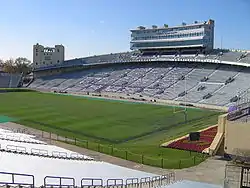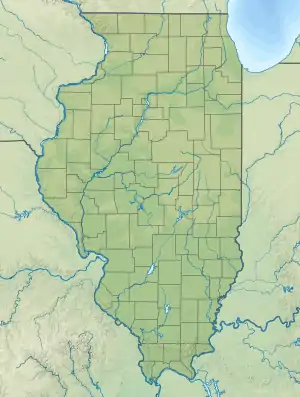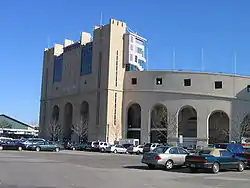Ryan Field (stadium)
Ryan Field is a stadium in Evanston, Illinois, a suburb north of Chicago. Near the campus of Northwestern University, it is primarily used for American football, and is the home field of the Northwestern Wildcats of the Big Ten Conference. It is the only FBS stadium without permanent lighting. Its current seating capacity is 47,130.
 View from northeast corner in 2006 | |
 Ryan Field Location in Illinois  Ryan Field Location in the United States | |
| Former names | Dyche Stadium (1926–1996) |
|---|---|
| Location | 1501 Central Street Evanston, Illinois, U.S.[1] |
| Coordinates | 42°3′56″N 87°41′33″W |
| Owner | Northwestern University |
| Operator | Northwestern University |
| Capacity | 47,130 (1997–present) 48,187 (1996) 49,256 (1982–1995) 48,500 (1975–1981) 55,000 (1954–1974) 52,000 (1949–1953) 47,000 (1927–1934) 25,000 (1926) |
| Surface | Grass: 1997–present Astroturf: 1973–1996 Grass: 1926–1972 |
| Construction | |
| Broke ground | April 8, 1926[2] |
| Opened | October 2, 1926[3] |
| Renovated | 1996 |
| Expanded | 1949, 1952 |
| Construction cost | $2.6 million (original)[4] ($37.5 million in 2019[5]) 1996 renovation: $20 million |
| Architect | James Gamble Rogers[1] |
| General contractor | J. B. French Construction Company[1] |
| Tenants | |
| Northwestern Wildcats (NCAA) (1926–present) | |
Opened 95 years ago in 1926, it was named Dyche Stadium for William Dyche, class of 1882, a former Evanston mayor and overseer of the building project. The stadium was renamed Ryan Field in 1997 in honor of the family of Aon Corporation founder Patrick G. Ryan, who was then the chairman of Northwestern's board of trustees. The renaming was made by the other members of the board in recognition of the Ryan family's leadership and numerous contributions to Northwestern, including the lead gift to the Campaign for Athletic Excellence, Northwestern's fundraising drive for athletic facilities.
History
At the time it was constructed, Dyche Stadium was considered one of the finest college football stadiums in the country.[6] The stadium originally consisted of two semi circular grandstands on either sideline, with the west (home) sideline having a small, curved upper deck whose 2 ends abut in matching concrete towers. The purpose of the curved grandstands was to maximize the number of fans sitting close to the action.[6] End zone seating was later added in the south, and in 1952 McGaw Memorial Hall was built beyond the north end zone.
The stadium had a natural grass surface when it opened. It switched to artificial turf in 1973 and was used until 1996. Prior to the 1997 season, the natural grass surface was restored and the playing surface was lowered approximately 5 feet (1.5 m) to improve sight lines from the lowest rows of the stadium.
The Chicago Bears played their first home game of the 1970 season vs. the Philadelphia Eagles at Dyche Stadium on September 27 as an experiment; the NFL had required that the Bears move out of Wrigley Field because its seating capacity was under 50,000, which was below the minimum set out by the newly constituted post-merger NFL. Also, the Chicago Cubs were in a September pennant race with the Pittsburgh Pirates and New York Mets in the National League East.[7] If Wrigley Field was needed for postseason baseball games, the temporary grandstand for football along the east sideline (in right and center field) would not be available until late October. After Evanston residents petitioned city officials to block the team from moving there permanently and the Big Ten Conference opposed the Bears' use of Northwestern's stadium, the Bears ended up moving to Chicago's Soldier Field the following year.
The stadium hosted the 1932 Women's (July 16) and 1948 Men's (July 9–10) US Olympic Trials for track and field. The venue also hosted the NCAA track and field championships in 1943.
It also hosted the summer College All-Star Game in 1943 and 1944, which had usually been instead held at Chicago's Soldier Field. Both games were played at night with the use of temporary lights.[8] The college all-stars held their practices for the game at Dyche Stadium in years such as 1934 and 1935.[9]


Renaming controversy
Northwestern's decision to rename Dyche Stadium to Ryan Field defied the university's own 1926 resolution that forbade such a change. School officials said that a private institution can override previous boards' decisions, and dismissed the earlier resolution as a "show of appreciation." But NU did not explain why a mere gesture of appreciation would expressly state that any football stadium at any location would retain the name Dyche, as indeed the 1926 resolution does. The Dyche family wasn't notified of the change; NU claimed that the only descendant they found was a grandniece, despite other family members living in Chicago and being listed in the phone book. After the family protested, NU said it was willing to install an informational plaque at the stadium, noting its former name.[10]
Transportation
The closest transit stations are Metra commuter railroad's Central Street station and Chicago Transit Authority's Central station on the Purple Line.
In popular culture
Parts of The Express: The Ernie Davis Story, a 2008 film about Syracuse University Heisman Trophy winner Ernie Davis starring Rob Brown as Davis, and Dennis Quaid as Davis' Syracuse coach, Ben Schwartzwalder, were filmed at Ryan Field.[11]
Parts of Four Friends, a 1981 film directed by Arthur Penn, were filmed at Dyche Stadium.
References
- "Ryan Field". Ballparks.com. Retrieved November 13, 2013.
- "Northwestern Starts Work on New $1,000,000 Stadium". Chicago Daily Tribune. April 8, 1926. p. 26. Retrieved November 13, 2013.
- LaTourette, Larry (2005). Northwestern Wildcat Football. Chicago: Arcadia Publishing. p. 35. ISBN 0-7385-3433-1. Retrieved September 28, 2011.
- "Northwestern's New Field Named Dyche Stadium". Chicago Tribune. October 28, 1926. Retrieved September 28, 2011.
- Federal Reserve Bank of Minneapolis. "Consumer Price Index (estimate) 1800–". Retrieved January 1, 2020.
- Pridmore, Jay (2000). Northwestern University: Celebrating 150 Years. Northwestern University Press. p. 126.
- "Pennant race at a glance". Spokesman-Review. (Spokane, Washington). September 16, 1970. p. 16.
- http://articles.chicagotribune.com/1988-08-31/sports/8801270026_1_northwestern-dyche-stadium-all-star
- Schmidt, Raymond (2001). Football's Stars of Summer: A History of the College All-Star Football Game Series of 1934-1976. Lanham, Maryland; London, England: Scarecrow Press. ISBN 9780810840270. Retrieved April 21, 2015.
- Morrissey, Rick (September 19, 1997). "For Dyche Clan, Perpetuity Didn't Last Long". Chicago Tribune. Chicago, Illinois. Retrieved July 10, 2016.
- Bhattarai, Abha (May 1, 2007). "Bringing Hollywood to NU". Daily Northwestern. Northwestern University. Archived from the original on May 3, 2007. Retrieved May 6, 2007.
External links
| Wikimedia Commons has media related to Ryan Field (stadium). |